Scottish alcohol sales drop as minimum price kicks in
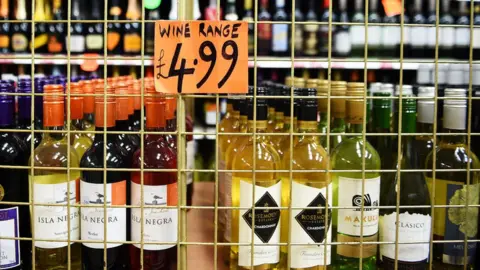 Getty Images
Getty ImagesScots bought less alcohol in 2018 than any year since records began in the early 1990s, according to a new report.
Analysis by NHS Health Scotland found Scottish adults still bought more alcohol than people in England and Wales on average but the gap narrowed.
A minimum price per unit of alcohol was introduced on 1 May last year in a bid to tackle Scotland's drink culture.
The authors of the report said it was not possible to quantify the impact but "early indicators were encouraging".
Scotland was the first country in the world to introduce minimum unit pricing (MUP), although others places operate different forms of price control.
Minimum pricing was largely aimed at raising the cost of cheap lager, cider and spirits sold in supermarkets and off-licences to reduce consumption.
The 2019 MESAS (Monitoring and Evaluating Scotland's Alcohol Strategy) report said:
- The average Scottish adult bought 19 units of alcohol per week (The UK recommended limit was 14 units a week for men and women).
- The annual volume of "pure alcohol" in drinks sold in Scotland was 9.9 litres per adult, down about 3% from 10.2 litres in 2017.
- The volume of alcohol is 9% higher than in England and Wales (9.1 litres) - the smallest difference since 2003.
- Since 2010 the volume of pure alcohol sold per adult through supermarkets and off-licences has fallen by 9% in Scotland.
- It has risen by 3% in England and Wales over the same period.
The report said alcohol continued to be a leading cause of illness and early death in Scotland, with an average of 22 people dying of alcohol-related illness every week.
The Scottish government brought in minimum unit pricing to target the price of cheap, high-strength alcohol, which it said attracted problem drinkers.
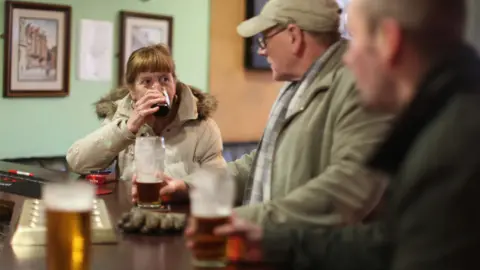 Getty Images
Getty ImagesThe new law looked at the amount of alcohol in a drink and set a minimum price of 50p for each unit.
Under the rules, a 70cl bottle of vodka, at a strength of 37.5% abv, would be 26.25 units and cost £13.13.
Lucie Giles, public health intelligence adviser at NHS Health Scotland, said the minimum pricing law led to the biggest rise in the average price of alcohol for a decade and a "substantial" fall in the volume of alcohol sold at very low prices.
For the first time, less alcohol was sold below 50p per unit in Scotland than south of the border.
 Getty Images
Getty ImagesFollowing Scotland's introduction of the policy, members of the Welsh Assembly passed legislation to introduce a minimum price for alcohol - the plans are yet to be implemented.
Similar legislation has been considered for England but is not currently on the table.
Ms Giles said: "From the data in this report it's not possible to quantify the full contribution of MUP (minimum unit pricing) on alcohol prices and sales, but these are encouraging early indicators."
She said alcohol was still a "significant public health issue" and people in Scotland's poorest areas continued to experience the most harm.

Analysis by Lisa Summers, BBC Scotland health correspondent
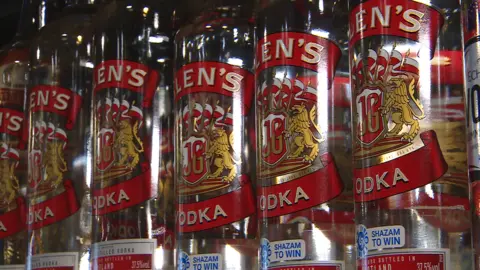
Shopkeepers say they have seen a shift in the type of drinks people are buying and doctors say that is reflected on the wards.
The official figures show a fall in sales but no real change in what we are choosing to drink.
It is a small percentage of people who are the most problematic drinkers, a significant proportion of those live in poverty.
Most who work in this area say there needs to be a much wider package of support to really address the country's unhealthy relationship with alcohol.
One man I spoke to said minimum pricing will make no difference for this group. "If they can't afford it, they'll steal it" he said.
We have been seeing a steady decline in alcohol sales over the past decade or so, hence the optimism today, but not a rush to claim success.
The truth is, it is too early to tell whether minimum pricing is having an impact on Scotland's health.
No other country in the world has tried it so a full analysis will take years to complete.

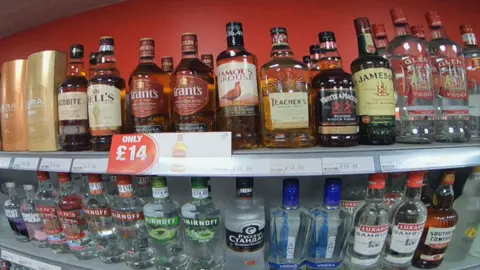
The MESAS report looks at alcohol sales for 2018 but data on harm caused by drinking was for the previous year, before minimum pricing was introduced.
It shows that alcohol-specific death rates were consistently higher in Scotland than in England and Wales.
In 2017, rates were twice as high in men and 55% higher in women.
In the most deprived areas, rates of alcohol-specific death were more than seven times higher than in the least deprived.
Dr Ewan Forrest, a liver specialist at Glasgow Royal Infirmary, told BBC Scotland it was "probably too early to say" if there had been a reduction in alcohol harm.
"We are still seeing a lot of alcohol-related liver disease so I'm not thinking the measures taken have solved the problem but I'm hoping they have moved us in the right direction," he said.

Dr Forrest said he hoped to see a reduction in alcohol-related liver deaths over the next five years.
He said: "By reducing the overall consumption of alcohol and pushing some people towards stopping alcohol I hope we can prevent people who have liver disease developing full-blown liver failure."
In response to the MESAS report, BMA Scotland chair Dr Lewis Morrison said minimum pricing was "still very much in its infancy" but the results from the first year were "extremely encouraging".
Alison Douglas, from Alcohol Focus Scotland, said the figures suggested the policy was "having a real impact on the way we drink in Scotland".
The Scottish government's Health Secretary Jeane Freeman said it was a "promising start" and the fall in sales was "moving in the right direction".
Scots buy more from off-licences
The MESAS report shows that while Scots buy more alcohol in pubs than people in England and Wales, it is off-licences and supermarkets where the biggest difference lies.
The rates of sales of spirits from off-licences were 37% higher in Scotland than in England and Wales, with sales of vodka per adult being 87% higher.
Since 1994 off-trade sales in Scotland have increased by 36% while sales in pubs, clubs and restaurants have fallen by 44%.
Abdul Majid, who runs a small supermarket in Bellshill, North Lanarkshire, said his turnover had not been affected by the minimum pricing rules but his customers had changed what they bought.
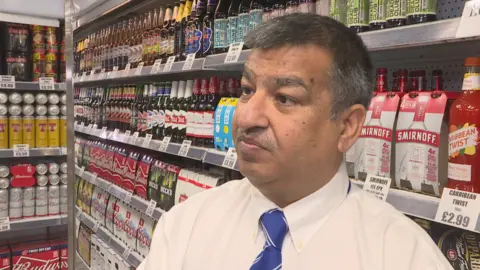
He said they had moved away from high-strength (7.5% abv) ciders, which used to cost as little as £4 for three litres but could not now be sold for less than £11.25.
Mr Majid said people were buying more alcopops or small bottles of spirits such as vodka.
He said people had not understood the new law when it was first introduced.
"They know now that it is a minimum unit price so no matter which retailer they go to the minimum price doesn't change.
"It means that my prices and the bigger supermarket prices are now on a level playing field."
According to Mr Majid, another consequence of the price rise has been a sharp rise in shoplifting.
"We are always really surprised at the people we catch," he said. "It's not always who you would expect."
